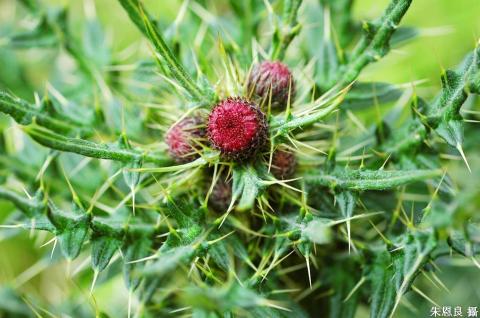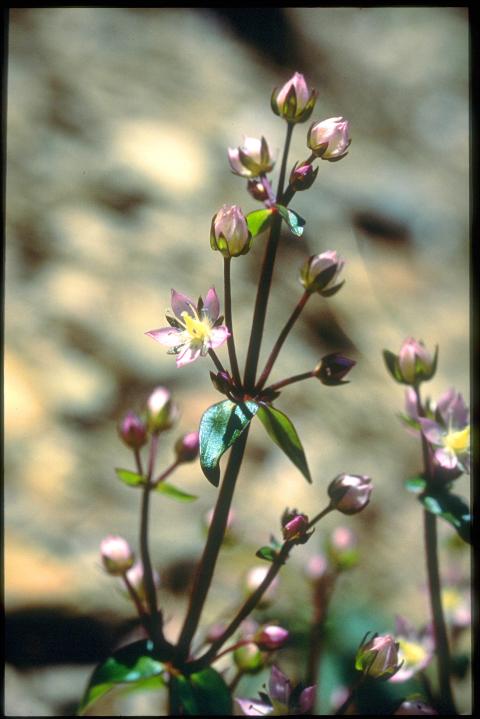At an international conference on Sept. 26, Academia Sinica academician Chou Chang-hung said that with the onset of global warming, wild plant species at average to high altitudes have been showing a tendency to migrate to higher altitudes, adding that if these species continue to migrate they will eventually reach a point where there is nowhere to grow. Chou says that six plant species indigenous to Taiwan, including Yushan’s Hypericum nagasawai, will soon face extinction, and says that the preservation of genetic resources brooks no delay.
The Taiwan Endemic Species Research Institute (TESRI) under the Council of Agriculture held the International Conference on the Collection and Preservation of Plant Genetic Resources on Sept. 26, with Peter H. Raven, a former science consultant for the Clinton administration and longtime director of the Missouri Botanical Garden, around a dozen other international experts from South Africa, England, Germany and China, as well as Academia Sinica’s Chou, Lee Chia-wei, a professor in National Ching Hua University’s Department of Life Sciences, and Chiu Chi-jung and Chung Kuo-fang, both professors in National Taiwan University’s School of Forestry and Resource Conservation, presenting papers at the conference.
Chou says research shows that from 1906 to 2006 plant life at average to high altitudes in the Hehuanshan area gradually migrated to higher altitudes due to global warming, averaging 3.6m per year. If this migration trend is not slowed down, there will eventually be no more land available for the plants to grow, meaning that at least six of Taiwan’s native plant species — Anaphalis morrisonicola, Artemisia morrisonensis, Swertia randaiensis, Hypericum nagasawai, Angelica morrisonicola, and Cirsium arisanensis — potentially face extinction.

Photo courtesy of the Endemic Species Research Institute
照片由特有生物研究保育中心提供
TESRI director Tang Hsiao-yu says that they are currently in the process of planning facilities for the preservation of plant species in high-altitude mountain areas. Still at the preliminary phase of planning, they have decided to create a preservation area at Hehuanshan and will be working to collect and preserve 500 or so of the plant genetic resources currently growing at high altitudes there. With enough manpower and funding, the institute hopes to expand its collection and preservation endeavors to Southeast Asia in the future, potentially benefiting their work by holding exchanges with international experts and learning from the experiences of others, Tang says.
(Liberty Times, Translated by Kyle Jeffcoat)
全球氣候暖化,中高海拔野生植物出現往高海拔地區遷移生長的趨勢,中研院院士周昌弘九月二十六日在一場國際研討會中提出警訊,強調若高山植物持續往高處遷移,未來將無處可去,而台灣特有種的玉山金絲桃等六種植物恐將絕滅,種原蒐藏保育已刻不容緩。

Photo courtesy of the Endemic Species Research Institute
照片由特有生物研究保育中心提供
農委會特有生物研究保育中心二十六日舉辦植物種原蒐集與保育國際研討會,包括曾任美國前總統柯林頓科學顧問的密蘇里植物園園長彼得‧雷文與來自南非、英國、德國與中國等十二名國際專家學者與中研院院士周昌弘、清大生命科學系教授李家維與台大森林資源系教授邱圻榮、鍾國芳均與會發表報告。
周昌弘指出,從一九○六至二○○六年之間在氣候暖化影響下,研究紀錄顯示在合歡山區的中高海拔野生植物,每年以三點六公尺速率往高海拔遷移生長,若此趨勢未見減緩,最後將無處可去,其中至少有玉山抱莖籟簫、細葉山艾、巒大當藥、玉山金絲桃、玉山當歸與阿里山薊等六種植物極可能面臨絕滅。
特生中心主任湯曉虞表示,目前正積極籌設高山植物種原保存設施,初步選定合歡山地區設立保存場地,就現有五百多種高山植物種原進行蒐藏保存,未來若人力、財力允許更將擴展蒐藏範圍至東南亞地區,藉著國外學者專家的經驗交流,有助推動種原保存工作。
(自由時報記者陳信仁)

California will phase out certain ultra-processed foods from school meals over the next decade under a first-in-the-nation law signed on Oct. 8 by Gov. Gavin Newsom. The law seeks to define ultra-processed foods, the often super-tasty products typically full of sugar, salt and unhealthy fats. The legislation requires the state’s Department of Public Health to adopt rules by mid-2028 defining “ultra-processed foods of concern” and “restricted school foods.” Schools have to start phasing out those foods by July 2029, and districts will be barred from selling them for breakfast or lunch by July 2035. Vendors will be banned from providing the “foods

Have you ever bought a new smartphone and suddenly found yourself dissatisfied with your perfectly fine headphones? Before long, you’ve purchased premium wireless earbuds, a protective case and a fast-charging station. What begins as a single acquisition snowballs into a shopping spree—this is the Diderot effect in action. Named after the 18th-century French philosopher Denis Diderot, the Diderot effect originates from an essay he wrote. In it, he recounted receiving a luxurious robe as a gift. As lovely as it was, the robe clashed with the rest of his humble belongings. One by one, he replaced his possessions to match the

A: The 23rd Taiwan Pride parade will be marching again on Saturday, Oct. 25. B: Will the parade kick off from Taipei City Hall Plaza as usual? A: Yup, and there will be over 110 LGBT-themed booths at the Rainbow Festival in the plaza. B: The organizer is reportedly teaming up with Japanese, South Korean and other international groups. A: So we are likely to see more foreign visitors from across the world. Hopefully, this year’s parade can smash the record of 200,000 marchers set in 2019. A: 第 23 屆台灣同志遊行本週六即將登場。 B: 遊行還是從台北市政府前廣場出發嗎? A: 對,廣場「彩虹市集」還有超過

對話 Dialogue 清清:華華,你知道這禮拜為什麼又有三天連假嗎? Qīngqing: Huáhua, nǐ zhīdào zhè lǐbài wèishénme yòu yǒu sān tiān liánjià ma? 華華:知道啊!10月25號是臺灣光復節,從今年起,又是可以放假的國定假日了。剛好碰到禮拜六,所以禮拜五多補一天假。 Huáhua: Zhīdào a! Shí yuè èrshíwǔ hào shì Táiwān Guāngfù Jié, cóng jīnnián qǐ, yòu shì kěyǐ fàngjià de guódìng jiàrì le. Gānghǎo pèngdào lǐbài liù, suǒyǐ lǐbài wǔ duō bǔ yì tiān jià. 清清:對了! 我想起來了,聽我爸媽說過,以前十月有好幾天都放假,光復節是其中之一。 Qīngqing: Duìle! Wǒ xiǎng qǐlái le, tīng wǒ bàmā shuōguò, yǐqián shí yuè yǒu hǎojǐ tiān dōu fàngjià, Guāngfù Jié shì qízhōng zhī yī. 華華:光復節是慶祝日本人在二次世界大戰結束後,離開臺灣的日子。 Huáhua: Guāngfù Jié shì qìngzhù Rìběn rén zài Èrcì Shìjiè Dàzhàn jiéshù hòu líkāi Táiwān de rìzi. 清清:那是一九四五年的事了。 Qīngqing: Nà shì yī jiǔ sì wǔ nián de shì le. 華華:沒錯,對臺灣來說,是很重要的歷史。 Huáhua: Méicuò, duì Táiwān